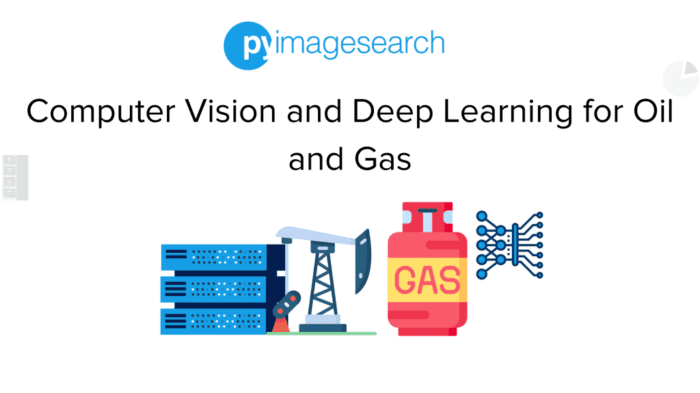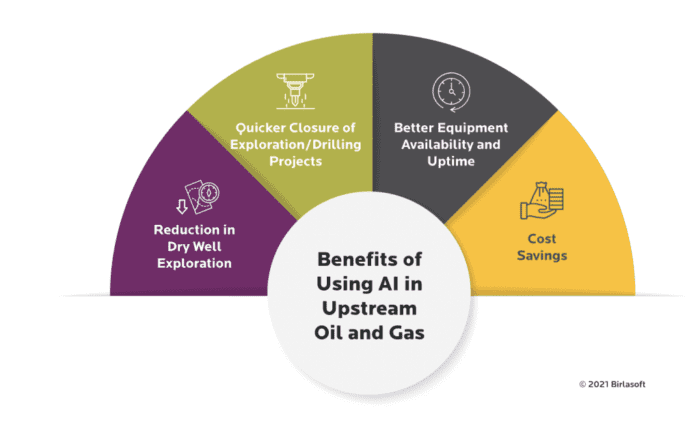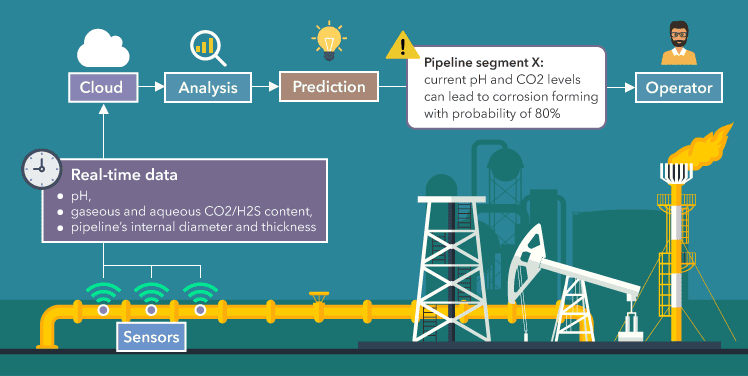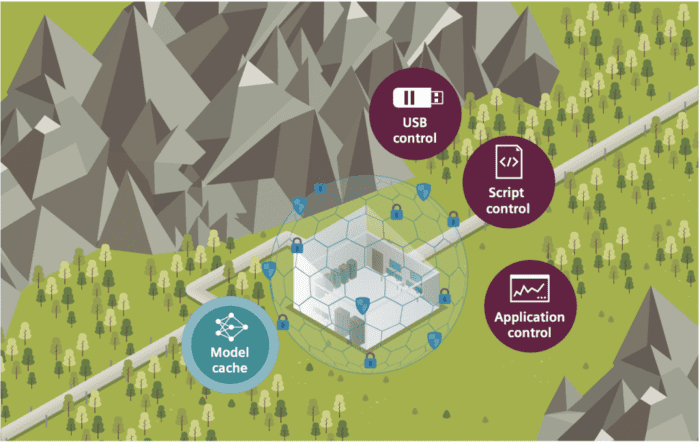Table of Contents
Computer Vision and Deep Learning for Oil and Gas
Despite the widespread diffusion of renewable energy, oil and gas are among the highly valued commodities in the energy sector. However, commodity cycles, capital planning challenges, and increasing operational risk have propelled the oil and gas industry to make more intelligent and efficient decisions.

In a 2018 Ernst & Young (EY) survey, Artificial Intelligence (AI)/Machine Learning (ML) didn’t even rank in the top five technologies used by seven global oil and gas supermajors (Figure 1). Further, they feel that in the coming years, technologies like robotic process automation (RPA) (25%) and advanced analytics (25%), but not AI/ML, will have the most significant and positive effect on their businesses.

AI/ML have enormous potential in the oil and gas industry, and by not considering it, leaders in the sector risk being blindsided. It can help reduce costs, add capacity and capability, speed decision-making, and improve quality while managing risk. This will allow machines and humans to work together in collectively intelligent ways, propelling the sector into the digital age.
This series is about CV and DL for Industrial and Big Business Applications. This blog will cover the benefits, applications, challenges, and tradeoffs of using deep learning for oil and gas.
This is the 1st in a 5-lesson course: CV and DL for Industrial and Big Business Applications 102.
- Computer Vision and Deep Learning for Oil and Gas (this tutorial)
- Computer Vision and Deep Learning for Transportation
- Computer Vision and Deep Learning for Logistics
- Computer Vision and Deep Learning for Healthcare
- Computer Vision and Deep Learning for Education
To learn about Computer Vision and Deep Learning in Oil and Gas, just keep reading.
Benefits
Security
The working environment in oil and gas plants is toxic and dangerous for employees. Exposure to varying temperatures and fumes can be hazardous to employees’ life. Further, any non-compliance with safety standards can cause injuries and heavy penalties. The trained algorithm can analyze and send alerts in case of any deviation and help one stay proactive for the safety and security of employees and plants.
Production Optimization and Estimation
Since oil prices vary, the industry needs to optimize its production at every step. Factors like flow rates, pressure, etc., affect oil and gas production. With sensor data, AI algorithms can generate real-time updates, which can help maintain favorable operation settings.
Reduce Production and Maintenance Costs
Different temperatures and weather conditions can lead to corrosion and degradation of oil and gas while being dispersed through pipelines. In combination with the Internet of Things (IoT), AI can use knowledge graphs and predictive intelligence to detect early signs of damage and corrosion. Companies can also plan maintenance activities and avoid downtime due to equipment failure. Moreover, the adoption and integration of AI-powered defect detection solutions are economical, making it worthwhile compared to the existing process.
A few more benefits are shown in Figure 2.

Applications
Maintenance
Predictive Maintenance
An average offshore company experiences roughly 27 days of unplanned downtime in a year, costing it a whopping $38 million. As a result, AI-based predictive maintenance solutions are expected to grow significantly. AI models can predict equipment failure, reduce the risk of costly accidents, reduce downtime, and improve compliance with safety standards.
IoT sensors can generate terabytes of data recording pressure, flow, soil movement, and corrosion which can be analyzed through AI to create real-time updates on equipment health. For example, Chevron has turned to IoT development to roll out a predictive maintenance solution that helps to identify corrosion and pipeline damages (Figure 3). They use sensors installed across the pipeline to measure variables like pH, gaseous and aqueous CO2/H2S content, and the internal diameter and thickness of the pipeline.

AI is also capable of predicting and preventing cavitation, which is a phenomenon occurring in centrifugal pumps when a sudden reduction in fluid pressure results in the production of bubbles that can later collapse and cause dangerous shock waves. In addition, the AI-equipped system can automatically move the fluid flow to a different pump and prevent bursting bubbles from damaging the pipeline.
Maintenance Using Digital Twins
Many offshore structures have exceeded their design lifetime. Decommissioning them can lead to losing the oil and gas they produce, and upgrading them will need huge investments. Over the years, the sector has relied on digital copies of structures, known as digital twins, that monitor the health of their physical assets (e.g., pipelines, rigs, valves, etc.).
Using Light Detection and Ranging (LiDAR) to generate 3D point clouds and analytics for plant construction, experts can predict the behavior of a structure and assess its maintenance needs, thus prolonging its lifespan by a significant margin.
However, these models do not consider the changes in an asset’s actual, real-life physical conditions, which may influence its performance. To curb this limitation, Ramboll is developing data mining and pattern recognition algorithms to identify the actual needs through structural monitoring and update the digital twin accordingly (Figure 4). This ensures that the structure is tested, assessed, and optimized, thus reducing the costs for full-scale testing in the field under actual operational conditions.
Maintaining Blowout Preventers
Blowout preventers (BOPs) are essential for keeping the seal in place in the most challenging pressure conditions or against uncontrolled flow/formation kicks that may occur during drilling. However, because of their remote locations, limited monitoring, and hard troubleshooting, the failure of a BOP can be catastrophic.
Digital companies such as Deepwater Subsea are now exploiting AI and ML to understand the health of BOPs in real-time and reduce rig non-productive time (NPT). Pattern recognition algorithms can leverage rig data from faults, alarms, and subsea control systems.
Optimization
Optimized Reservoir Management
The oil and gas sector has to actively identify new wells, which can cost up to $150 million for single drilling. Near-perfect characterization of geological structures deep under the surface and fluid dynamics is necessary for efficient field development. However, data collected over several decades is often soiled, unstructured, and highly disorganized, making the success rates less than 20%.
Companies like Lucidworks are deploying AI-based solutions to spot better wells with a reduced amount of water and gas accurately and quickly. ML can be applied to drilling to draw insights from strata permeability, thermal gradients, pressure differentials, seismic vibrations, and much more. This helps geoscientists make informed decisions, discover new energy sources, and reduce the environmental impact of new wells.
Optimized Procurement
AI-based procurement solutions can generate interconnected digital supply networks (DSNs), enabling dynamism, flexibility, and efficiency in the planning and execution of the oil and gas industry. Further, it can help firms automate purchase-to-pay, identify critical and noncritical supply chain bottlenecks, and gain visibility into planned and actual figures by the supplier, material, geography, etc.
In addition, AI can augment procurement experts’ decision-making capabilities with additional insights from data crunching and analysis of highly complex and large data sets to solve traditional problems.
Optimized Financial Planning
A better forecast of demand, sales, and financials can help companies plan their production and distribution supply. For example, AI algorithms can easily predict the demand for a particular product assisting companies in ensuring they have the effect in the right place at the right time to serve customer orders on time and know regions where to focus. Further, companies running gas stations can also benefit from predicting the demand for consumer goods to reduce their inventory capital.
The oil and gas sector has a complex supply chain involved in making decisions like crude purchase, purchase price, transportation to the refinery, refining operations, gantry operations, and retail sale of end products. AI can thus help coordinate the operations team with the warehouse and ensure the availability of crucial parts. In addition, it can support proper planning and execution, optimal route selection, etc.
In a nutshell, AI can aid in predicting the market price of crude oil and finished products, proper planning and scheduling, enabling optimization of the natural basket, creating an intelligent warehouse, maintenance of inventories, handling shipping operations, risk hedging, improving delivery times, and reducing overall costs.
Safety and Security
Workplace Safety
The oil and gas industry is vulnerable to theft of valuable equipment on unattended sites, vandalism, and sabotage which can lead to leakage and damages. Groundwater contamination via leakage is a severe and costly problem and leads to fines, criminal charges, and terrible impacts on reputation. Further, because of their economic significance, oil and gas industries can also be a potential target for terrorist attacks and acts of sabotage.
AI can monitor unattended operation sites 24/7 for security concerns like intrusion and send instant alerts to concerned authorities as soon as a security concern occurs, or an unauthorized person enters (e.g., Chooch AI). In addition, automation and effective false alarm filtering technology reduce the need to watch multiple screens simultaneously, allowing security officers to focus on real threats (Figure 5).
Further, due to the harsh weather conditions, extreme operating conditions, and hazardous processes, the oil and gas industry faces the constant risk of fires, explosions, and spills, risking workers’ lives. One such incident happened in the California-based Tesoro Martinez Refinery plant, where a sulfuric acid spill burned two employees. Hence, they must adhere to extensive regulatory compliance to ensure workplace safety. Computer vision algorithms can assist in site inspections and monitoring in real-time. In addition, video analytics from the camera feed can verify if workers adhere to safety procedures like wearing protective equipment and preventing slip and fall accidents due to slippery surfaces.

Defect Detection and Asset Protection
Material degradation and corrosion can lead to severe accidents and damages. Popoola et al. (2013) state that “the annual cost of corrosion in the oil and gas production industry is estimated to be $1.372 billion.” To handle this problem, AI-based tools are used to monitor and check equipment health conditions and trigger alerts in case of any defect. Such systems can also monitor leaks, toxic levels, and system breakdowns.
AI-Led Cybersecurity
In a Ponemon Institute survey, Siemens reported that 70% of oil and gas organizations had encountered security compromises. For example, consider a cyber attacker who obstructed the video stream, enabling him to monitor offshore drilling operations or delay well-flow information. Such information is necessary for blowout preventers to stop fluid eruptions, which can have devastating impacts. Moreover, a hacker could also vary the motor speed and thermal capacity of the sucker rod pump, slowing down or even halting the drilling process.
Siemens and SparkCognition have revolutionized cyber security recently with DeepArmor Industrial (Figure 6), which leverages artificial intelligence (AI) to monitor and detect cyber attacks to protect the oil and gas industry’s endpoint operational technology.

Assistance
The oil and gas industry heavily relies on the expertise of a few master experts. Unfortunately, when these people retire, their knowledge is lost, and new employees must go through procedural information buried under thousands of documentation pages. Keeping this in mind, IBM created a digital assistant using its Watson AI technology to help less experienced employees in day-to-day work and troubleshooting.
The AI learned from 600,000 pages of documentation and reports to provide expert-level answers to commonly asked questions. With the help of the virtual assistant, engineers now spend 75% less time researching solutions, all with hands-free voice commands. Moreover, the AI algorithm used in the assistance can also learn new information from new employees as they get experienced (Figure 7).
Exploration
Cracks and fractures in the ocean floor, known as “seeps,” are a potential source of crude oil and natural gas. Hydrocarbons reach the surface like a freshwater spring and form an oil seep. Natural oil seeps constitute at least 60% of the oil found underneath the earth’s surface in the North American region. Oil from underwater seeps can damage the environment by releasing methane and other light hydrocarbons into the atmosphere. Exploring these seeps and tapping them can protect the environment and provide oil and gas operators with a profitable energy source.
ExxonMobil, with MIT engineers, has developed an AI-based software used by NASA’s Mars Curiosity Rover to design AI-powered underwater robots suited for ocean exploration. These AI machines can monitor the depths of the oceans, map them, and detect natural seeps (Figure 8).

Challenges
According to an EY survey (Figure 9) of the super majors, the major challenge faced by 50% of major oil and gas companies is managing the balance between internal development, service providers, and acquisitions. Hence it is essential to understand the broader challenges of AI rather than just business impact. Other challenges of AI for oil and gas companies are:

Adoption
Adopting AI/ML requires a fundamental shift in how work is carried out and decisions are made. They also need a lot of effort and investment in educating existing employees on using these services. In addition, data and AI specialists must be hired to support the development of AI infrastructure (algorithms and datasets) and customized tools. Hence, support from top management is required to get sponsorships, ensure suitable investment, and drive transformation.
Data
AI algorithms need a vast and good quality of data to work correctly. Oil and gas fields can generate a large amount of raw data. However, the quality and accuracy of data are often low, making the training of AI algorithms difficult. Companies need to redesign and adjust their organizational structures and processes to get quality data. In addition, data storage needs to be centralized to allow people in different warehouses to access the software.
Another key direction is to adopt intelligent algorithms like small data learning that aim to train AI algorithms with a small number of examples. Along the same lines, an efficient adaptation of pre-trained models can increase the applicability of AI-aided tools.
Open Collaboration
While open collaborations are becoming the new standard in the tech and AI sector, oil and gas companies are not famous for their collaborations, especially between competitors and in domains such as AI. Even though companies announce to open source their data and claim the necessity of cross-company and cross-border data sharing, the reality is rather pessimistic. Hence, oil and gas companies need to rethink the strategies for collaborating and interacting with universities that can provide a good source of AI talent.
Summary
Because of commodity cycles, capital planning challenges, and increasing operational risk, the oil and gas industry has started using AI for more intelligent and efficient decisions. AI can help reduce costs, add capacity and capability, speed decision-making, and improve quality while managing risk in the following ways.
- Maintenance: AI can feed on the data (pressure, flow, soil movement, and corrosion) generated by IoT sensors to create real-time updates on equipment health.
- Optimization: AI can aid in the prediction of the market price of crude oil and finished products, proper planning and scheduling, enabling optimization of the natural basket, creating an intelligent warehouse, maintenance of inventories, handling shipping operations, risk hedging, improved delivery times, and reduction in overall costs.
- Security: AI can monitor unattended operation sites 24/7 for security concerns like intrusion and send instant alerts to concerned authorities as soon as any security concern occurs or an unauthorized person enters.
- Assistance: With the help of the AI-based virtual assistant, engineers now spend less time researching solutions, all with hands-free voice commands.
- Exploration: AI-powered underwater robots suited for ocean exploration can monitor the depths of the oceans, map them, and detect natural seeps.
However, AI in the oil and gas industry comes with its challenges.
- Adoption: Shifting to the AI paradigm requires much effort and investment in educating existing employees on using these services. In addition, data and AI specialists must be hired to support the development of AI infrastructure (algorithms and datasets) and customized tools.
- Data: Oil and gas fields can generate a large amount of raw data. However, the quality and accuracy of data are often low, making training AI algorithms difficult.
- Collaboration: Oil and gas companies are not famous for their collaborations, especially between competitors and in domains such as AI.
I hope this post helped you understand the benefits, applications, challenges, and tradeoffs of using deep learning in oil and gas. Stay tuned for another lesson where we will discuss deep learning and computer vision applications for transportation.
Consultation Services
Do you need some help with your industrial application of AI? Learn more about our consulting services.
Citation Information
Mangla, P. “Computer Vision and Deep Learning for Oil and Gas,” PyImageSearch, P. Chugh, A. R. Gosthipaty, S. Huot, K. Kidriavsteva, and R. Raha, eds., 2022, https://pyimg.co/zfg51
@incollection{Mangla_2022_CVDLOG,
author = {Puneet Mangla},
title = {Computer Vision and Deep Learning for Oil and Gas},
booktitle = {PyImageSearch},
editor = {Puneet Chugh and Aritra Roy Gosthipaty and Susan Huot and Kseniia Kidriavsteva and Ritwik Raha and Abhishek Thanki},
year = {2022},
note = {https://pyimg.co/zfg51},
}

Unleash the potential of computer vision with Roboflow - Free!
- Step into the realm of the future by signing up or logging into your Roboflow account. Unlock a wealth of innovative dataset libraries and revolutionize your computer vision operations.
- Jumpstart your journey by choosing from our broad array of datasets, or benefit from PyimageSearch’s comprehensive library, crafted to cater to a wide range of requirements.
- Transfer your data to Roboflow in any of the 40+ compatible formats. Leverage cutting-edge model architectures for training, and deploy seamlessly across diverse platforms, including API, NVIDIA, browser, iOS, and beyond. Integrate our platform effortlessly with your applications or your favorite third-party tools.
- Equip yourself with the ability to train a potent computer vision model in a mere afternoon. With a few images, you can import data from any source via API, annotate images using our superior cloud-hosted tool, kickstart model training with a single click, and deploy the model via a hosted API endpoint. Tailor your process by opting for a code-centric approach, leveraging our intuitive, cloud-based UI, or combining both to fit your unique needs.
- Embark on your journey today with absolutely no credit card required. Step into the future with Roboflow.

Join the PyImageSearch Newsletter and Grab My FREE 17-page Resource Guide PDF
Enter your email address below to join the PyImageSearch Newsletter and download my FREE 17-page Resource Guide PDF on Computer Vision, OpenCV, and Deep Learning.

Comment section
Hey, Adrian Rosebrock here, author and creator of PyImageSearch. While I love hearing from readers, a couple years ago I made the tough decision to no longer offer 1:1 help over blog post comments.
At the time I was receiving 200+ emails per day and another 100+ blog post comments. I simply did not have the time to moderate and respond to them all, and the sheer volume of requests was taking a toll on me.
Instead, my goal is to do the most good for the computer vision, deep learning, and OpenCV community at large by focusing my time on authoring high-quality blog posts, tutorials, and books/courses.
If you need help learning computer vision and deep learning, I suggest you refer to my full catalog of books and courses — they have helped tens of thousands of developers, students, and researchers just like yourself learn Computer Vision, Deep Learning, and OpenCV.
Click here to browse my full catalog.